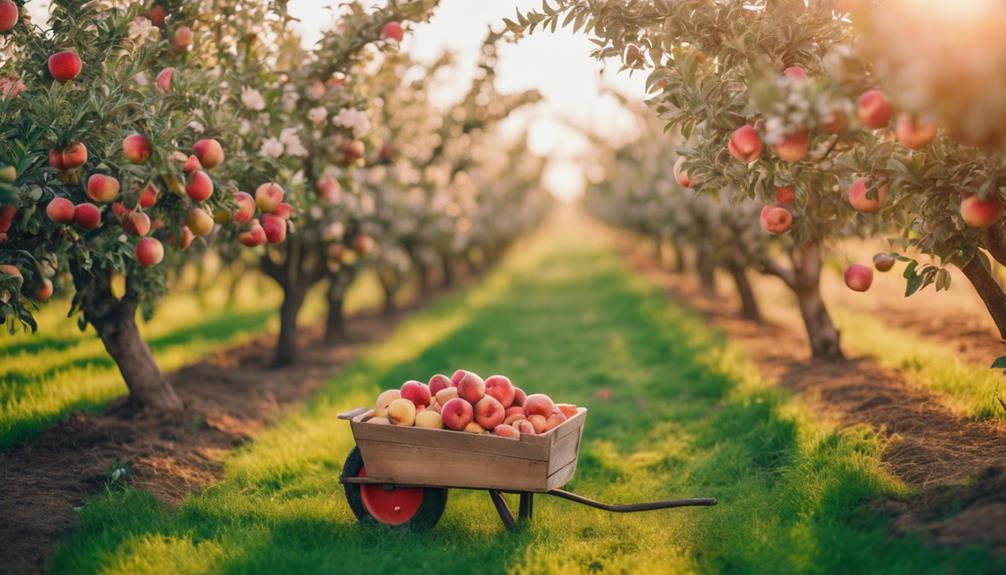You can transform your outdoor space and conserve water by mastering the art of rainwater harvesting. Start by setting up a collection system with a properly connected barrel to catch rainwater from your downspouts. This water is perfect for nurturing your garden and reducing municipal reliance during dry spells. Maintain your system by regularly cleaning your barrel and checking for blockages. You might also want to explore decorative options like rain chains to enhance your landscape. The benefits are plentiful, and there's so much more you can learn to optimize your rainwater harvesting journey.
Key Takeaways
- Attend local workshops to learn region-specific techniques for efficient rainwater harvesting and system setup.
- Choose a durable rain barrel with at least a 42-gallon capacity and ensure proper elevation for easy access.
- Implement a collection system using downspouts or rain chains, and incorporate filters to keep water clean.
- Regularly maintain your system by cleaning barrels, checking for blockages, and ensuring a secure lid to prevent contamination.
Advantages of Rainwater Harvesting
One major advantage of rainwater harvesting is that it provides a sustainable and chlorine-free water source, perfect for your garden and landscaping needs.
Rainwater is softer than tap water, free from harmful chemicals like chlorine, lime, and calcium, making it ideal for irrigating your plants. This naturally warm water helps promote healthy growth while reducing the risk of harmful sediment buildup.
During droughts, having a rainwater collection system guarantees your garden stays hydrated without relying on municipal supplies.
Additionally, it helps minimize stormwater runoff, reducing pollution in local water bodies.
Setting Up a Collection System
To effectively set up a rainwater collection system, start by attending local workshops to learn best practices tailored to your region. Once you're equipped with knowledge, choose a barrel with at least a 42-gallon capacity.
Here are some essential steps to take into account:
- Connect a downspout to efficiently collect rainwater.
- Make sure the design includes incoming, outgoing, and overflow features.
- Use a spigot for easy filling of watering cans or hoses.
Utilizing Collected Rainwater

After setting up your rainwater collection system, you can start utilizing the harvested rainwater for a variety of practical purposes.
You can fill watering cans to nourish your garden or directly water your plants and lawn from the barrel. If you want to automate your watering routine, connect a soaker hose for consistent moisture.
Additionally, consider washing your car or pet with this eco-friendly water source. Using two barrels can help manage overflow and guarantee you always have enough water on hand.
By incorporating these practices, you not only conserve water but also support your garden's health while reducing reliance on municipal supplies.
Enjoy the benefits of your sustainable water source!
Rain Barrel Construction Tips
When constructing your rain barrel, make sure it features a sealed lid with threaded openings for easy cleaning and access to fittings. A well-built rain barrel not only collects water efficiently but also guarantees it remains clean and safe for use.
Here are some essential tips to keep in mind:
- Choose a flat-bottom barrel for increased stability.
- Paint white plastic barrels to reduce algal growth.
- Drill an overflow hole to direct excess water away from your home's foundation.
Maintenance for Longevity

Regular maintenance of your rain barrel guarantees it functions efficiently and extends its lifespan. Start by cleaning your barrel every few months to remove debris and prevent algae growth.
Inspect the spigot and overflow openings for blockages, guaranteeing a smooth water flow. It's vital to check the lid; make sure it's sealed tightly to keep out pests and contaminants. If you notice any cracks, repair or replace the barrel promptly.
Consider adding mosquito control, like Bacillus thuringiensis, to prevent larvae. During colder months, drain your barrel to avoid freezing and cracking.
Exploring Rain Chains
Rain chains offer a beautiful and functional alternative to traditional downspouts, enhancing both the aesthetics and efficiency of your rainwater collection system. These handcrafted structures channel rainwater down in a visually pleasing way, while also producing soothing sounds as the water flows.
Here are some benefits of using rain chains:
- Aesthetic Appeal: They add unique charm to your landscape.
- Easy Installation: Simply attach a hook in your gutter and hang the chain.
- Versatile Designs: Customize them with various materials and decorative elements.
Customizing Your System

Customizing your rainwater collection system allows you to tailor it to your specific needs and aesthetic preferences. Start by choosing the right materials and components that best suit your space. Consider adding decorative elements like rain chains or unique barrels to enhance your landscape.
Here's a quick reference table to help you decide on your customization options:
| Feature | Options |
|---|---|
| Barrel Material | Plastic, Wood, Metal |
| Collection Method | Downspouts, Rain Chains |
| Filter System | Mesh, Screen, Sand |
| Overflow Management | Hose, Diverter, Soaker Hose |
| Aesthetic Add-ons | Plants, Paint, Decorative Stones |
With these choices, you'll create a system that's functional and visually pleasing!
Frequently Asked Questions
How Can I Estimate Potential Rainwater Collection for My Roof Size?
To estimate potential rainwater collection for your roof, multiply your roof area by rainfall depth in inches. For example, a 1,200 sq ft roof can yield about 625 gallons per inch of rain.
Are There Legal Regulations Regarding Rainwater Harvesting in My Area?
In some areas, rainwater harvesting is permitted, while others impose strict regulations. You can often collect around 625 gallons per inch of rainfall from a 1,200 sq ft roof. Check local laws for specifics.
Can Rainwater Be Used for Drinking After Treatment?
Yes, you can use treated rainwater for drinking. After proper filtration and disinfection, it becomes safe. Always check local regulations and guidelines to guarantee you're meeting health standards before consuming harvested rainwater.
What Types of Plants Benefit Most From Rainwater Irrigation?
Imagine lush gardens thriving under gentle rain. You'll find native plants, herbs, and vegetables benefit most from rainwater irrigation, as they adapt well to local conditions, flourishing with the soft, nutrient-rich water you collect.
How Can I Prevent Algae Growth in My Rainwater Barrels?
To prevent algae growth in your rainwater barrels, keep them covered, use dark containers, and consider adding mosquito control methods like Bacillus thuringiensis. Regularly clean the barrels to maintain a healthy water supply.
Conclusion
By mastering rainwater harvesting, you're not just conserving water; you're investing in a sustainable future. The practice of rainwater harvesting helps to reduce the demand on municipal water supplies and can contribute to the preservation of natural water sources. In addition, rainwater harvesting is an essential skill for individuals or communities living in survival retreat land, where access to clean water may be limited. By investing in rainwater harvesting, you are not only securing a sustainable future for yourself, but also for future generations.
Remember, 'Every little bit helps.' Whether you're nurturing your garden or washing your car, every drop counts.
So grab those tools, set up your collection system, and enjoy the benefits of harnessing nature's free resource.
You'll feel good knowing you're making a positive impact on both your wallet and the environment.
Start your journey to self-sufficiency today!










